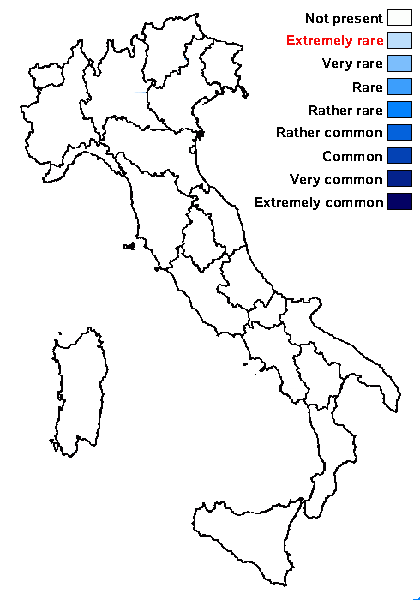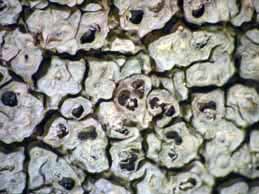Pertusaria parotica Sipman
in Sipman & Raus, Willdenowia, 29, 1/2: 274, 1999.
Synonyms:
Distribution:
Description: Thallus crustose, episubstratic, grey white (turning pale brown in the herbarium), forming over 10 cm wide patches delimited by a thin, dark prothallus, areolate-papillose, sometimes split by partial cracks, the sterile areoles 0.3-0.6(-1) mm wide, initially rather flat but soon strongly convex, raised and forming 0.5 mm tall papillae, the largest areoles fertile, sometimes up to almost 2 mm wide and c. 0.5-1 mm tall. Apothecia immersed in the fertile areoles, one or more per areole, with an expanded, 0.1-0.5 mm wide, black but often whitish-pruinose disc and a thick to finally excluded thalline margin, seemingly short-lived and leaving yellowish scars. Epithecium dark grey; hymenium colourless; paraphyses branched and anastomosing; hypothecium colourless. Asci 2-spored, broadly cylindrical, the apex with a broad ocular chamber, the outer sheath K/I+ blue, otherwise K/I-, Pertusaria-type. Ascospores 1-celled, hyaline, ellipsoid, 100-160 x 50-70 μm, smooth- and thick-walled. Pycnidia immersed on top op c. 0.5 mm wide, vaulted areoles, with blackish, impressed ostioles. Conidia elongate-ellipsoid, c. 6-7 x 1 μm. Photobiont chlorococcoid. Spot tests: thallus (especially medulla) K+ yellow turning red (small plate-like crystals), C-, KC-, P+ orange-yellow, UV+ blue-white. Chemistry: salazinic acid and two fatty substances resembling lichesterinic and protolichesterinic acids.Note: a Mediterranean species of siliceous rocks, known from Greece. To be looked for in Mediterranean Italy.
Growth form: Crustose
Substrata: rocks
Photobiont: green algae other than Trentepohlia
Reproductive strategy: mainly sexual

Predictive model
Growth form: Crustose
Substrata: rocks
Photobiont: green algae other than Trentepohlia
Reproductive strategy: mainly sexual

Predictive model


